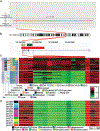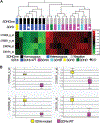Recurrent epimutation of SDHC in gastrointestinal stromal tumors
- PMID: 25540324
- PMCID: PMC7670881
- DOI: 10.1126/scitranslmed.3009961
Recurrent epimutation of SDHC in gastrointestinal stromal tumors
Abstract
Succinate dehydrogenase (SDH) is a conserved effector of cellular metabolism and energy production, and loss of SDH function is a driver mechanism in several cancers. SDH-deficient gastrointestinal stromal tumors (dSDH GISTs) collectively manifest similar phenotypes, including hypermethylated epigenomic signatures, tendency to occur in pediatric patients, and lack of KIT/PDGFRA mutations. dSDH GISTs often harbor deleterious mutations in SDH subunit genes (SDHA, SDHB, SDHC, and SDHD, termed SDHx), but some are SDHx wild type (WT). To further elucidate mechanisms of SDH deactivation in SDHx-WT GIST, we performed targeted exome sequencing on 59 dSDH GISTs to identify 43 SDHx-mutant and 16 SDHx-WT cases. Genome-wide DNA methylation and expression profiling exposed SDHC promoter-specific CpG island hypermethylation and gene silencing in SDHx-WT dSDH GISTs [15 of 16 cases (94%)]. Six of 15 SDHC-epimutant GISTs occurred in the setting of the multitumor syndrome Carney triad. We observed neither SDHB promoter hypermethylation nor large deletions on chromosome 1q in any SDHx-WT cases. Deep genome sequencing of a 130-kbp (kilo-base pair) window around SDHC revealed no recognizable sequence anomalies in SDHC-epimutant tumors. More than 2000 benign and tumor reference tissues, including stem cells and malignancies with a hypermethylator epigenotype, exhibit solely a non-epimutant SDHC promoter. Mosaic constitutional SDHC promoter hypermethylation in blood and saliva from patients with SDHC-epimutant GIST implicates a postzygotic mechanism in the establishment and maintenance of SDHC epimutation. The discovery of SDHC epimutation provides a unifying explanation for the pathogenesis of dSDH GIST, whereby loss of SDH function stems from either SDHx mutation or SDHC epimutation.
Copyright © 2014, American Association for the Advancement of Science.
Conflict of interest statement
Figures



References
-
- Gill AJ, Succinate dehydrogenase (SDH) and mitochondrial driven neoplasia. Pathology 44, 285–292 (2012). - PubMed
-
- Pollard PJ, Brière JJ, Alam NA, Barwell J, Barclay E, Wortham NC, Hunt T, Mitchell M, Olpin S, Moat SJ, Hargreaves IP, Heales SJ, Chung YL, Griffiths JR, Dalgleish A, McGrath JA, Gleeson MJ, Hodgson SV, Poulsom R, Rustin P, Tomlinson IP, Accumulation of Krebs cycle intermediates and over-expression of HIF1α in tumours which result from germline FH and SDH mutations. Hum. Mol. Genet 14, 2231–2239 (2005). - PubMed
-
- Selak MA, Armour SM, MacKenzie ED, Boulahbel H, Watson DG, Mansfield KD, Pan Y, Simon MC, Thompson CB, Gottlieb E, Succinate links TCA cycle dysfunction to oncogenesis by inhibiting HIF-α prolyl hydroxylase. Cancer Cell 7, 77–85 (2005). - PubMed
Publication types
MeSH terms
Substances
Associated data
- Actions
Grants and funding
LinkOut - more resources
Full Text Sources
Other Literature Sources
Molecular Biology Databases
Miscellaneous

